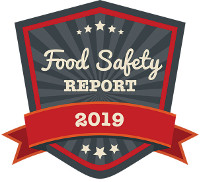Safety is a broad term applied to many aspects of our daily lives. We hear and read about national border safety in passionate, fever-pitched language; marketing vehicles as “safest in class;” and those who use social media platforms and financial institutions and make online purchases may be concerned with the safety of their personal information. In these cases, the desire is to protect the integrity of borders, physical well-being and information.
So why does the topic of food safety only seem to be scrutinized when an anomaly or breakdown of safety processes occur in the supply chains?

Table of Contents:
The global food system needs to be explored in a holistic manner to understand the interconnectivity and multifaceted aspects of producing, transporting, processing and consuming food items. Food chains are more interconnected now than at any other time. Each link in these complex chains is vulnerable to systemic breakdown and external factors, many of which are outside control of food processors. What can we do to reinforce food safety within production facilities and make our “link” more robust?
This article will focus on the human element of food safety, which presents the most vulnerability to food safety. There are five steps that can be implemented to educate, train and reinforce food safety. First, people need to be educated in what constitutes food safety. Second, policies and procedures need to be clearly defined with associated expectations. Third, clear and consistent communication is required to ensure proper conveyance of the policies. Fourth, training needs to be made personal and relatable. Finally, you must lead by example.
Defining food safety
Food safety is a broad topic that can be assigned various definitions based on a person’s experience and understanding. According to the U.S. Department of Agriculture (USDA), four guidelines need to be followed to keep food safe: clean, separate, cook and chill. The Food and Drug Administration’s (FDA’s) Food Safety Modernization Act (FSMA) calls attention to the fact “workers can introduce contamination while handling produce or food contact surfaces. All personnel should not only be qualified to perform their assigned duties, but should understand how their actions impact food safety and the regulatory requirements that apply to their assigned duties.” Both regulatory bodies present broad definitions for food safety and place a significant burden on food processors to develop policies and train employees.
Policies and procedures
Any food safety program or process needs to be grounded in sound programs and policies. By having well-defined and clear policies, most questions or misunderstandings can be eliminated. It is incumbent on food manufactures to establish policies that address food safety and expectations from all individuals. “Food safety is the responsibility of everyone,” says Ruth Bitterman, North America quality assurance, regulatory and sustainability manager for Healthy Times/Swisse.
Policies typically are created by a corporate department to ensure consistency throughout facilities. Generally accepted principles such as good manufacturing processes (GMPs), hazardous analysis and critical control points (HACCP), standard operating procedures (SOPs) sanitation standard operating procedures (SSOPs) and other prescribed documented processes are incorporated. Policies should establish solid foundations and enhance other manufacturing and quality processes to be communicated to all employees.
Communication
Communication is challenging, requiring a significant amount of energy and commitment from all participants. We are faced with multiple challenges when communicating policies. These challenges include culture, language, literacy and comprehension. One can deliver a well-prepared science-based presentation to workers that may not be understood or resonate with individuals.
“Hey, I’m here to work and go home, not learn about food safety,” may be a statement from a production worker. “I worried about getting product out the door, not trying to win quality points here,” could be a sentiment from a supervisor.
The bulk of responsibility rests with an organization’s managers to communicate the importance of food safety. The topic should not be considered a stand-alone program but an integral part of all aspects of the organization. Facilities’ proper communication of food safety begins with the attitude of management.
“Management is tasked with changing the culture and truly understanding the significance as well as relaying that message to the employees and practicing it themselves,” says Bitterman. Communication through training is needed for a consistent, repeatable and reinforceable food safety program.
Training
I feel training is an overused word that has diluted its use and application. Any process should be considered part of an ongoing effort of process improvement. Good training builds on the foundation of a sound base, reinforced with refresher courses. Mandatory training should not be viewed as a schedule disruptor or cost event. Take advantage of the time to deliver a concise message. I have found the key to training is to understand the audience and make the material relatable.
First, understand your audience (employees sitting in a conference room, training center or cafeteria) has not signed up and paid money for a food safety seminar. A reality check is to know that most workers look at training classes as an hour off the production floor. Some managers consider training a disruption of schedules and production. Also, managers feel pressure from “corporate” to meet production numbers in spite of training time cutting into the production schedule. So, with time constraints and pressure, make the relevance of food safety relatable to individuals.
Relating a common message to a diverse work force can be daunting. I have found that videos and relatable pictures/images are highly valuable tools to convey concepts and programs. Most people understand universal images and comparisons: good/bad, yes/no, right/wrong, correct/incorrect.
In order to ensure participants paid attention during a training session, several programs and methods require attendees to answer questions. These programs provide a documented record for employers while encouraging participation in the event. Participation by all individuals at a production facility as well as corporate reflects an effort to provide training for all in an organization. Such training can provide a means to engage management and allow them lead by example.
Leading by example
Actively and positively participating in training by management is critical. Grumbling and complaining by management regarding training does not convey a message of importance or value in the time or topic. By presenting a clear, unified message, an organization can establish a firm foundation to hold all employees accountable. The message conveyed through written policies is a first step for a food safety program, but management in any organization and facility must lead by example. Individuals on the production lines are highly aware of management personnel and how food safety is placed in order of importance.
A culture of food safety starts at the top. I have witnessed situations where corporate personnel, contractors or visitors are not held to the same food safety standards as employees. What do you think is going through the minds of employees when they see a tour of visitors walking through a facility not following food safety policies? Bitterman says, “The best training is ‘lead by example.’ If we tell employees that they must do something and here is why, but don’t do it ourselves, how can we hold them to these standards?”
Summary
All should agree that food safety is paramount to an overall efficient and effective food manufacturing facility. One should also agree training is important to improve the awareness of food safety. Some disagreements may occur over the amount of time committed, forum or methods used for training. The five steps outlined in this article can provide you and your organization tools to improve the culture regarding food safety. It is much easier to ensure a robust food safety program instead of handling the fallout from a preventable foodborne illness, acute injury or recall. NP



Report Abusive Comment